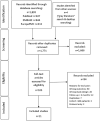Quantifying the risk of SARS-CoV-2 reinfection over time
- PMID: 34043841
- PMCID: PMC8209951
- DOI: 10.1002/rmv.2260
Quantifying the risk of SARS-CoV-2 reinfection over time
Abstract
Despite over 140 million SARS-CoV-2 infections worldwide since the beginning of the pandemic, relatively few confirmed cases of SARS-CoV-2 reinfection have been reported. While immunity from SARS-CoV-2 infection is probable, at least in the short term, few studies have quantified the reinfection risk. To our knowledge, this is the first systematic review to synthesise the evidence on the risk of SARS-CoV-2 reinfection over time. A standardised protocol was employed, based on Cochrane methodology. Electronic databases and preprint servers were searched from 1 January 2020 to 19 February 2021. Eleven large cohort studies were identified that estimated the risk of SARS-CoV-2 reinfection over time, including three that enrolled healthcare workers and two that enrolled residents and staff of elderly care homes. Across studies, the total number of PCR-positive or antibody-positive participants at baseline was 615,777, and the maximum duration of follow-up was more than 10 months in three studies. Reinfection was an uncommon event (absolute rate 0%-1.1%), with no study reporting an increase in the risk of reinfection over time. Only one study estimated the population-level risk of reinfection based on whole genome sequencing in a subset of patients; the estimated risk was low (0.1% [95% CI: 0.08-0.11%]) with no evidence of waning immunity for up to 7 months following primary infection. These data suggest that naturally acquired SARS-CoV-2 immunity does not wane for at least 10 months post-infection. However, the applicability of these studies to new variants or to vaccine-induced immunity remains uncertain.
Keywords: COVID-19; SARS-CoV-2; reinfection.
© 2021 John Wiley & Sons Ltd.
Conflict of interest statement
No conflict of interest declared.
Similar articles
-
Reinfection with new variants of SARS-CoV-2 after natural infection: a prospective observational cohort in 13 care homes in England.Lancet Healthy Longev. 2021 Dec;2(12):e811-e819. doi: 10.1016/S2666-7568(21)00253-1. Epub 2021 Dec 1. Lancet Healthy Longev. 2021. PMID: 34873592 Free PMC article.
-
SARS-CoV-2 Reinfections in Health-Care Workers, 1 March 2020-31 January 2023.Viruses. 2023 Jul 14;15(7):1551. doi: 10.3390/v15071551. Viruses. 2023. PMID: 37515237 Free PMC article.
-
The Incidence of SARS-CoV-2 Reinfection in Persons With Naturally Acquired Immunity With and Without Subsequent Receipt of a Single Dose of BNT162b2 Vaccine : A Retrospective Cohort Study.Ann Intern Med. 2022 May;175(5):674-681. doi: 10.7326/M21-4130. Epub 2022 Feb 15. Ann Intern Med. 2022. PMID: 35157493 Free PMC article. Clinical Trial.
-
Risk for Reinfection After SARS-CoV-2: A Living, Rapid Review for American College of Physicians Practice Points on the Role of the Antibody Response in Conferring Immunity Following SARS-CoV-2 Infection.Ann Intern Med. 2022 Apr;175(4):547-555. doi: 10.7326/M21-4245. Epub 2022 Jan 25. Ann Intern Med. 2022. Update in: Ann Intern Med. 2023 Jan;176(1):85-91. doi: 10.7326/M22-1745. PMID: 35073157 Free PMC article. Updated. Review.
-
COVID-19 reinfection: a rapid systematic review of case reports and case series.J Investig Med. 2021 Aug;69(6):1253-1255. doi: 10.1136/jim-2021-001853. Epub 2021 May 18. J Investig Med. 2021. PMID: 34006572
Cited by
-
COVID-19 reinfections in Mexico City: implications for public health.Front Public Health. 2024 Feb 14;11:1321283. doi: 10.3389/fpubh.2023.1321283. eCollection 2023. Front Public Health. 2024. PMID: 38419814 Free PMC article.
-
CRISPR-Cas13a-powered electrochemical biosensor for the detection of the L452R mutation in clinical samples of SARS-CoV-2 variants.J Nanobiotechnology. 2023 Apr 29;21(1):141. doi: 10.1186/s12951-023-01903-5. J Nanobiotechnology. 2023. PMID: 37120637 Free PMC article.
-
Leveraging Large Language Models for Infectious Disease Surveillance-Using a Web Service for Monitoring COVID-19 Patterns From Self-Reporting Tweets: Content Analysis.J Med Internet Res. 2025 Feb 20;27:e63190. doi: 10.2196/63190. J Med Internet Res. 2025. PMID: 39977859 Free PMC article.
-
Increased risk of SARS-CoV-2 reinfection associated with emergence of Omicron in South Africa.Science. 2022 May 6;376(6593):eabn4947. doi: 10.1126/science.abn4947. Epub 2022 May 6. Science. 2022. PMID: 35289632 Free PMC article.
-
Reinfection in patients with COVID-19: a systematic review.Glob Health Res Policy. 2022 Apr 29;7(1):12. doi: 10.1186/s41256-022-00245-3. Glob Health Res Policy. 2022. PMID: 35488305 Free PMC article.
References
-
- Johns Hopkins University & Medicine . COVID‐19 Dashboard 2020. https://coronavirus.jhu.edu/map.html. Accessed February 6, 2021.
-
- HIQA. Health Information and Quality Authority . Protocol for evidence synthesis support—COVID‐19 2020. http://www.hiqa.ie/sites/default/files/2020‐05/Protocol‐for‐HIQA‐COVID‐1...
-
- Higgins JPT, Thomas J, Chandler J, Cumpston M, Li T, Page MJ, Welch VA, eds. Cochrane Handbook for Systematic Reviews of Interventions version 6.2 (updated February 2021). Cochrane; 2021. Available from www.training.cochrane.org/handbook - PubMed
-
- World Health Organization (WHO). Criteria for Releasing COVID‐19 Patients from Isolation: Scientific Brief. 2020. https://www.who.int/news‐room/commentaries/detail/criteria‐for‐releasing.... Accessed September 22, 2020.
Publication types
MeSH terms
Substances
Grants and funding
LinkOut - more resources
Full Text Sources
Other Literature Sources
Medical
Miscellaneous


